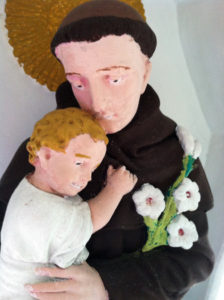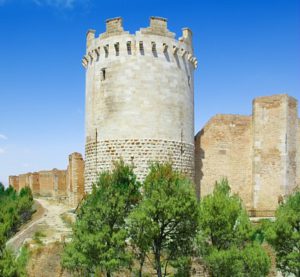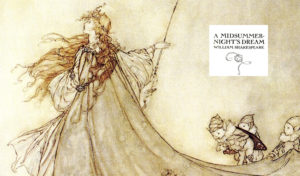I was just a kid when my family moved from New York to Florida. There are lots of things we left behind that, to this day, my mom laments. The square redwood picnic table in the patio. The midcentury modern backlit frieze of a dancing couple on the living room wall. The statue of St. Anthony in the backyard.
Each June, Grandma would spend a good part of each day sitting on an upright beach chair in front of that statue, saying her novena to St. Anthony, for June is his month, and today, the 13th, is his day. In old family photos, from before my time, the statue of St. Anthony is white, but at some point my dad painted it in full color. He painstakingly chose the colors and painted the statue with small brushes, down to the tiniest details, including facial expressions on St. Anthony and the Baby Jesus in his arms and the pistils and stamens of the flowers. Dad also painted St. Anthony’s hair and the top of his head all the same color brown, even though he is always depicted with a tonsure haircut, where the crown of the head is shaved bare. So our St. Anthony had a cap on his head. Dad also painted the little enclave in which the statue resided; it was pale blue, and I’m pretty sure he blew gold dust onto the wet paint behind the statue, so that there was some lovely golden illumination behind him, too. This is the St. Anthony I remember in our yard, and I remember thinking that I liked ours better than any other St. Anthony statue I had seen, and I had seen a lot of them, for Tony is a big deal amongst my people. He makes his appearance in the yards of many Italian American families, along with the Blessed Mother and St. Joseph. Perhaps it goes back to our Roman roots: we like our statues.
And so when we moved away, that statue of St. Anthony stayed behind. Chances are good he’s still there in the backyard on Victor Street; my dad and grandfather built that home, and my folks sold it to the son of another Italian friend who helped build it (a paisano, as we say). Now the house belongs to that man’s son and his family. That’s a long line of Italians, and I like to think that Grandma’s statue of St. Anthony has been watching over all of us the whole time.
For years we had no statue of St. Anthony at our new home in Florida. But one Christmas we had a brilliant idea: We would get Grandma a St. Anthony statue for her Christmas present. And so that year her present could not go under the tree (it was too heavy) and when it came time for her to open that present, we led her outside with her eyes closed and told her to open them at just the right time. As I recall, it was one of the best gifts we had given her (better than all those slippers she usually got). She was a little Italian woman with dark olive skin who didn’t care for much besides her family, what was for dinner, her stories (Another World was her favorite), and her saints, St. Joseph and St. Anthony especially. And for the rest of her life, she was able to sit in that upright lawn chair and say her novena to St. Anthony each June. Novena as in “nine,” nine days of prayers to St. Anthony, with her prayer books and rosary. She muttered the prayers under her breath, eyes fixed lovingly on St. Anthony in his little house. Grandpa would sit with her sometimes, and earlier on, again before my time, so would her best friend, Cummara Filomena. Filomena couldn’t read, so Grandma would read the novena aloud, and Filomena provided the “pray for us” response at the appropriate time.
As for St. Anthony himself, he was born in Lisbon in the late 12th century, but he spent most of his life in Italy. He was an early follower of St. Francis, and as a Franciscan, he wore the iconic brown cowled habit with that tonsured haircut that left the crown of his head bare, a clear portal, perhaps, from head to heaven. He is a populist saint, and is called upon for many reasons, but he is best known as the saint who helps you find lost articles. And so when we misplace our glasses or our keys, we say Tony Tony come around, something’s lost and must be found, an old children’s rhyme. And more often than not, it works. Perhaps because he is here, a presence we Italians like to talk to, like an old paisano.
Image: Detail of the St. Anthony statue we gave to Grandma for Christmas years ago. Dad eventually painted this one, too, though perhaps with not quite the attention to detail as the one that was left behind on Victor Street. You’ll notice that Tony is still wearing a cap on his head. Some things never change.


